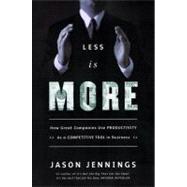
| Introduction | |
| Focus | |
| A Simple BIG Objective | p. 3 |
| The Hard Work Begins | p. 21 |
| Streamline | |
| The First Tactic: The Truth | p. 39 |
| Destroy the Bureaucracy and Make it Simple | p. 57 |
| Get Rid of the Wrong Executives and Managers...Fast | p. 71 |
| No Layoffs | p. 81 |
| WTGBRFDT? | p. 97 |
| The Real Financial Drivers | p. 115 |
| Systematize Everything | p. 127 |
| Continuous Improvement | p. 141 |
| Compensation | p. 155 |
| Digitize | |
| The Plug-in Myth | p. 171 |
| Motivate | |
| Keeping Everyone on the Same Productivity Page | p. 189 |
| Embody | |
| A Lean Spirit | p. 211 |
| Epilogue | p. 233 |
| Acknowledgments | p. 237 |
| Index | p. 241 |
| Table of Contents provided by Blackwell. All Rights Reserved. |
The New copy of this book will include any supplemental materials advertised. Please check the title of the book to determine if it should include any access cards, study guides, lab manuals, CDs, etc.
The Used, Rental and eBook copies of this book are not guaranteed to include any supplemental materials. Typically, only the book itself is included. This is true even if the title states it includes any access cards, study guides, lab manuals, CDs, etc.